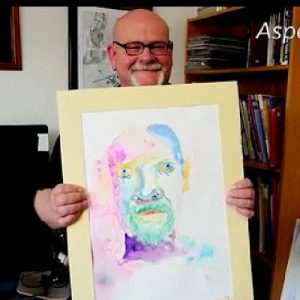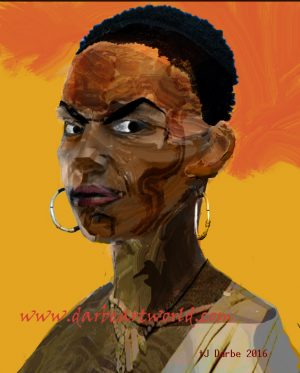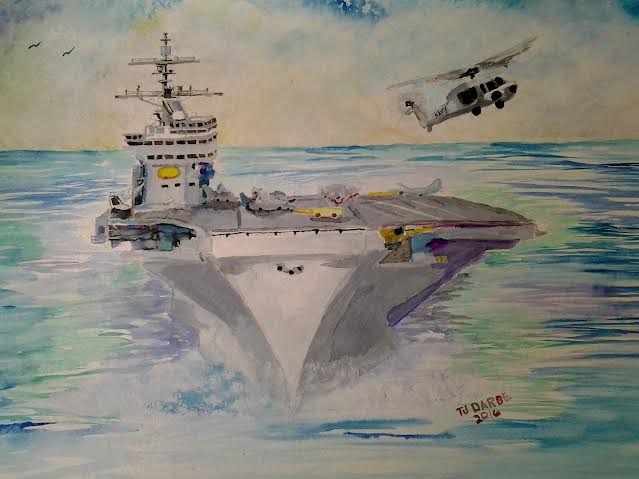Inspiring the community through the creative arts is at the heart of the Fine Arts Center’s mission, and this could not be achieved without the people involved with the FAC, whether through the museum, theatre or Bemis School of Arts. Members of the community make the FAC what it is, and the military is a very large part of the Colorado Springs community.
The Fine Arts Center has been offering Military Healing Programs in the community for nine years. It is our mission to educate the community about the power arts can have in the healing process. For active-duty military and veterans, we offer award-winning – and often life-changing – courses to provide healing opportunities for individuals and families dealing with trauma and post-traumatic stress issues. The arts enhance coping skills, manage stress and strengthen a sense of self. I met Tommy Darbe, who first participated in the military artistic healing program in 2013, and has since blossomed into a full-time artist.

Tell me about yourself Tommy.
I am a retired navy veteran – I was in the navy for 20 years. I came into the military artistic healing program because I was diagnosed with PTSD – I got out of the military and discovered a lot of mental health issues such as nightmares. It has taken me a long time to be able to talk about this; I collapsed with severe depression to the point where I was ready to commit suicide. My wife – bless her heart – saw what was happening and convinced me that I needed to get help. When I first met Kim and came into the program in 2013, I was a mess. In 2012, the number of veterans with posttraumatic stress spiked, and they found that it was because retired vets had gone on with their lives and raised their kids, and then when they became empty-nesters those normal stresses of life triggered PTSD. I fell into that category.
I had some experience with art – I started drawing in the navy. I sketched for stress release, and I never knew that I was giving myself therapy. When I got into the program, I was able to release a lot of things that I had been keeping bottled up inside. I saw people die, and that changes you a lot. I have been in some very extreme stress situations. The program allowed me to express those feelings in a positive way – to put things on paper that I couldn’t express in any other medium. It gave me a new lease on life – it saved my life. I would not be here today if I hadn’t got that help. So many vets commit suicide when they come home, because it doesn’t matter where you go, you will see things that give you trauma. For me, it was an accumulation of 20 years of stress and emotion.
So how did the classes allow you to let out all that emotion?
You do things like sling paint onto canvas, and yelling out all of your emotions, your anger and your rage. It’s a release. It’s a positive release.
And in the process, I even discovered that I have some marginal talent! Now I’ve had my own shows, and I have decided to take up art as a full time occupation, and tell my story about how my art is healing me. I don’t think you can ever really truthfully say that you are healed, but art makes you stable. You can see something beautiful that you have produced with your own hands – and that makes you see that life is worth living again. I still have flashbacks – me and my wife call them my navy dreams – but they are not nearly as prevalent as they used to me, and I see that as a result of the artistic healing.

It sounds like you have seen real results through the artistic healing program – how does that compare to any of the other forms of therapy that you have tried?
I went through a series of different therapies and, for me, art therapy had a more positive effect. It’s just not the same as other methods. You can sit down and write out your experiences and read them back to your therapist, and analyse yourself. But for me, that just brings back the memories. Whereas with the art, you get the emotions from those memories out; to be able to get those emotions out and express them was much more holistic and therefore a better method for me than traditional therapy.
Unlike other forms of therapy, it was incredible to be around like-minded people. I can relate to them on a level. I first had trouble relating to my own therapist because he hadn’t been in the military. When you talk to someone who’s never been in the military you sometimes get a blank stare. The military life is just alien to everything else. It’s a totally different type of discipline. But I have learnt that I am here now as a result of the bad things I saw in the military. This is an example of how good can come out of the bad. Without having to go through all that trauma, I may not have become an artist, which right now is my life passion.
You have had an extraordinary transformation from starting classes and being practically new to art to now being an artist yourself. Can you walk me through that progression?
Well, you know, it was actually quite a subtle progression. I had the same reaction to art classes at first as to other therapy. With the other therapy I’d do a couple of weeks and then call them up like ‘it’s not working for me.’ It was the same with this – I didn’t think it was working for me at first. But the great thing is that you work through a number of different techniques in classes – watercolor, writing, collage. It’s great because any one of those techniques might work for you. Because I was used to drawing already, it was the drawing, painting and watercolor that turned out to work best for me. I slowly began to realize that I would be depressed, and then I would get to work with my paints and pencils and get out whatever was in my heart. And then when I was finished, I would feel better! It must have taken three of four classes before it started to dawn on me that this was how it was working. I could get up from my art table and go away like, ‘yeah, I’m ready to face the day now.’
It sounds like the class worked wonders for you. Were there other participants for whom it didn’t have that affect?
There were a few who didn’t seem to click, but I have also found that there are a large number of people who took what they learnt in those classes and really ran with it. You can see when you meet them that the normalcy in their lives has been restored. I suppose it depends on how your mind works and where your head’s at when you start the program. But the ones it really works on are those who stay in class semester after semester – I’ve been taking part since 2013. I just took one summer off, but I am starting again with the Fall classes, because I found that, even just taking one summer off, I need that extra boost to learn new things. I have discovered things myself too – like Chinese brush painting – and found that these new things have a much more calming effect than traditional Western painting, so I’ve been trying to delve into them more. But what’s special is that you never go in and learn the same thing in these classes.
Kim, the class instructor, just won an award for her work – how was your experience of working with her?
Kim has an amazing capacity to interpret your art. When she first did it that was pretty scary for me – I was like she should open a psychic hotline or something! But it’s amazing how your subconscious can pick out colors and shapes that express what’s inside. She’s an amazing woman – she’s very deserving. She has a heart for veterans that never quits. Kim can get through to you without forcing her way in – she gets through in a quiet way.
It was Kim who also asked me if I wanted my work to be in a show. That in itself was therapeutic. When your art is out there, it’s like people can see into your soul. It can be disturbing both for them and for you. For the artist, we keep so much inside, and so it’s like suddenly you’re opening that up. PTSD sufferers bury themselves in a prison – I was in a deep pit for so long. When I sold my first piece of art I cried because I never conceived that someone could like my art – that showed so much of what was inside me – enough to buy it.
Kim also wanted me to speak to a few groups about my experience – I’ve always liked public speaking, and found that talking about my art is really therapeutic. People’s light comes on when you talk about your experience. When Kim asked me to introduce myself in that very first class, I just broke down because I couldn’t articulate those feelings. Now I’m comfortable enough.
I bet your family is incredibly proud.
They are – they love it. To them it’s like I’m a different person, and they love that I have become that different person. I have such a better relationship with my sons now that I used to.
What’s next for you?
Well, I want to set a goal to get a show out of state. I sent some artwork to a show for veterans by the Department for Defence in Washington, and I’m waiting to hear back. I’m also looking into doing something in Denver. That’s my next step – to get my art out of Colorado Springs and even out of Colorado.


